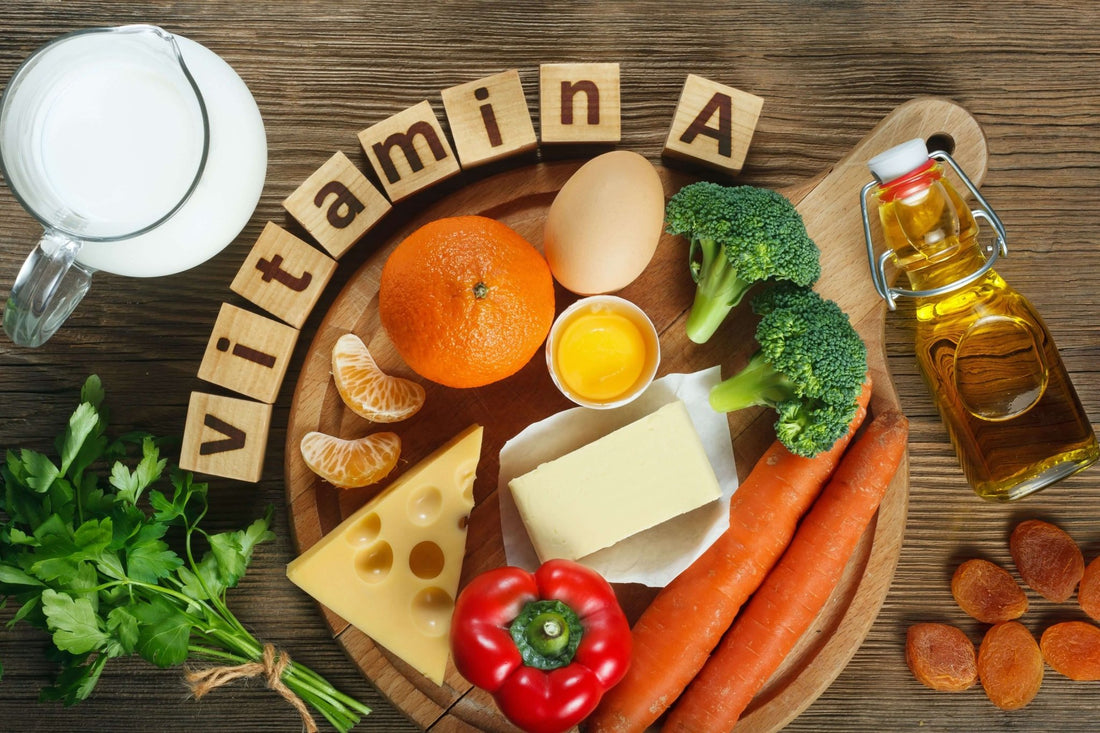
Vitamin A, its functions, how much you need and what happened if you don't get enough!
What you will learn from this post
Table of contents
- What is vitamin A?
- What are the functions of vitamin A?
- How much vitamin A do I need?
- What foods contain vitamin A?
- Does vitamin A interact with other nutrients?
- What happens if I have too little vitamin A?
- What happens if I have too much vitamin A?
- When should I pay extra attention to my vitamin A intake?
What is vitamin A?
Vitamin A is the generic name used for a group of fat-soluble compounds that include two main forms: carotenoids, found in plant and plant-based foods; and preformed vitamin A (or retinol), mainly found in animal products.
Carotenoids are pigments responsible for plant’s red, yellow and orange colours, which our bodies can absorb and convert to vitamin A. One of the most well-known and abundant carotenoids in nature is beta-carotene. There are also other types of carotenoids in foods, such as lycopene, lutein and zeaxanthin, which are not converted to vitamin A in our bodies but have other health benefits.
What are the functions of vitamin A?
Vitamin A plays a key role in developing and supporting our vision, keeping our immune system functioning properly and helping our cells and tissues grow and develop. Vitamin A is particularly important for reproduction, as it helps the normal growth and development of the embryo.

How much vitamin A do I need?
How much vitamin A you need per day changes according to your age, sex and life-stage.
The dietary reference values (DRV) for vitamin A are measured in μg of retinol equivalents (RE), a unit that takes into account the fact that we absorb retinol better than carotenoids.
|
1 μg of RFE is equivalent to: |
1 μg of of retinol |
|
6 μg of beta-carotene |
|
|
12 μg of other carotenoids |
The DRV* set for healthy adults (over the age of 18) is 650-750 μg RE per day. During pregnancy and lactation, needs can go up to 700 μg RE and 1300 μg RE per day, respectively. A diet with a lot of processed food usually lacks all kinds of nutrients. However, we can get enough vitamin A without any supplementation, by eating a balanced diet from a wide range of Real Foods.

* These values are based on the population reference intakes (PRI) estimates from the European Food Safety Authority (EFSA). They should not be interpreted as nutrient goals.
What foods contain vitamin A?
Vitamin A can be found in a variety of foods as retinol (mainly found in animal products) or as carotenoids (found in plants and plant-based foods).
Foods rich in retinol include:
- meat
- butter
- dairy
- eggs.
Foods rich in carotenoids include many vegetables and fruits such as:
- sweet potatoes,
- carrots,
- pumpkins,
- dark green leafy vegetables,
- sweet red peppers,
- mangoes and melons.

Does vitamin A interact with other nutrients?
In healthy individuals, imbalances of vitamin A do not seem to affect the levels of other nutrients. However, in people with iron deficiency, low levels of vitamin A can further reduce their levels of iron and lead to anemia caused by vitamin A deficiency.
What happens if I have too little vitamin A?
Too little vitamin A can lead to inflamed skin, night blindness, infertility, delayed growth and respiratory infections. People with wounds and acne may have lower levels of vitamin A in their blood and benefit with higher doses of the vitamin.
What happens if I have too much vitamin A?
It’s uncommon to have too much vitamin A from our diet, but harmful doses of vitamin A can be reached through concentrated supplements, so pay attention.
Too high levels of vitamin A in our bodies can cause skin disorders, nausea, vomiting, muscle problems and liver damage. It can be particularly harmful during pregnancy as it increases the risk of birth defects.
Healthy adults, including during pregnancy and lactation, are advised not to have more than 3000 μg RE per day, which is about four times the DRV for this vitamin. It’s also recommended that postmenopausal women who are at greater risk of osteoporosis, should not have more than 1500 μg RE per day, as it could increase the risk of bone fracture.
When should I pay extra attention to my vitamin A intake?
Most people can get the recommended amounts for this vitamin from a varied and balanced diet.

Children up to the age of 6 years old also need to ensure they have a healthy and balanced diet with enough sources of vitamin A as this vitamin is particularly important for their normal growth and development.
During pregnancy and lactation, the needs for vitamin A are higher to support the healthy development of the baby, as well as to compensate for losses through breast milk. However, high doses of vitamin A during pregnancy can also increase the risk of birth defects, so make sure to seek professional advice from your doctor or a qualified nutritionist/dietitian.
